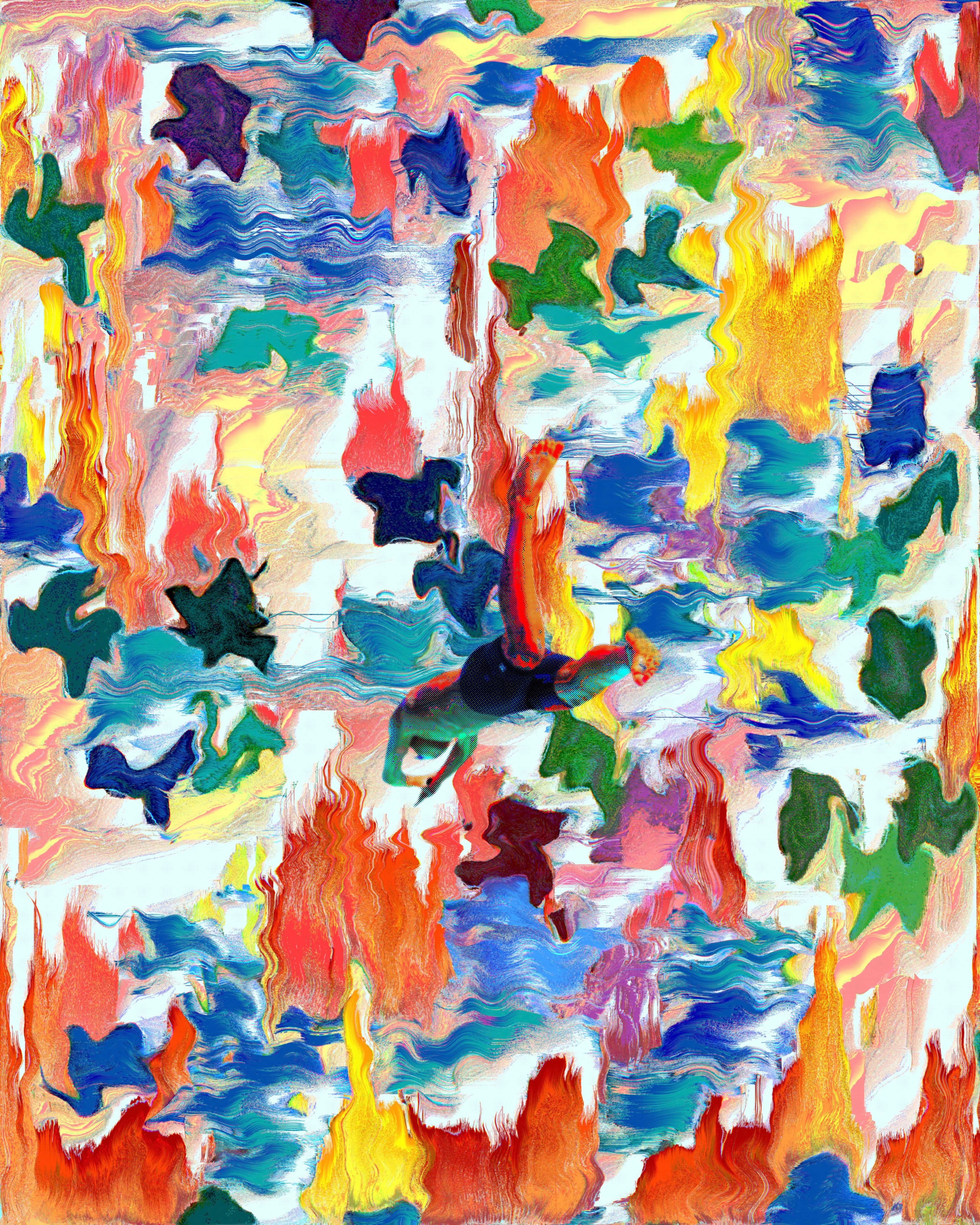Artistic genesis and musical influences
by Carlo Borloni
Pho's path began with an innate passion for music, which led him inexorably towards the labyrinthine corridors of the visual arts.
This mixture of auditory and visual elements in his work can be compared to the synaesthetic experiences evoked by Wassily Kandinsky, a pioneer of abstract art who often drew connections between music and painting.
For example, taking a cue from Compositions VI (1913), is known for its complexity and use of colours and shapes reminiscent of a musical symphony.
Kandinsky worked on these works as a composer works on a symphony, trying to create a work of art that had an emotional effect similar to that of music
Kandinsky believed that colours and shapes could express feelings in a similar way to music, a philosophy that parallels Pho's fusion of rhythmic and visual elements.

Compositions VI, Wassily Kandinsky,1913

Leap of Faith,Pho, 2022
Surrealism and the Subconscious Mind
At the heart of Pho's artistic oeuvre lies an unyielding fascination with the subconscious mind and its intricate rhythms.
Pho's work "The Path Less Travelled" where we find a subject walking on a staircase leading up to the sky in a landscape with warm tones that enclose a spiral in them brings to mind This focus is reminiscent of the surrealist traditions of Salvador Dalí.
Dalí's imagined piece, "The Bridge of Collapsed Dreams," captures the essence of his style by exploring themes of interruption, dream, and reality, combining symbolic and dreamlike elements.
Dalí's "controlled chaos" in such surreal landscapes, textured compositions find echoes in Pho's intuitive and fluid artistic process.
Pho's work invites viewers to confront the nuances of their innermost thoughts and emotions, much like how Dalí's works evoke the bizarre and hidden realms of the human psyche.

The Path Less Travelled, Pho, 2024

the Broken Bridge and the dream, Salvador Dali, 1945
Mixed Media and Contemporary Sensibilities
Pho's evolution from digital media to mixed media positions him within the context of contemporary artists like Anselm Kiefer.
Kiefer's use of diverse materials to create textured, multilayered works that explore themes of history, memory, and cosmic significance can be seen as a parallel to Pho's exploration of identity and introspection through various media.
Kiefer's artwork "Sternenfall (Falling Stars), 1995," for instance, utilizes materials such as lead and ash to convey a sense of historical depth and introspection, mirroring Pho's own approach to blending different media to express complex psychological landscapes.
Anselm Kiefer, for instance, has often grappled with heavy and complex themes in his work, navigating the tumultuous interplay between history, mythology, and personal identity.
His piece "Sternenfall (Falling Stars)" exemplifies the profound and sometimes dark introspection that characterizes much of his oeuvre.
Kiefer's resilience and dedication underscore the transformative power of art, much like Pho's journey through the turbulent waters of creative fervor and self-doubt.
As in "Sternenfall (Falling Stars)" in Pho's work "All the color is gone", is able to make us ask many questions, the work by looking at it does not give us answers.
The subject navigates in the dark, the tones given to the work mean that melancholy, doubt and searching take over.

Sternenfall (Falling Stars), Anselm Kiefer, 1995

All the color is gone, Pho, 2014
Challenges and Resilience in Artistic Pilgrimage
Pho's journey, marked by intense creative fervor and doubts about the viability of an artistic career, mirrors the experiences of many artists who have faced similar struggles.
Vincent van Gogh, for example, struggled with mental health issues and doubts throughout his life, channeling his emotional turbulence into his art.
Van Gogh's resilience and dedication resulted in a profound body of work that continues to inspire, much like Pho's own journey through the tumultuous waters of creative fervor and self-doubt.
Vincent Van Gogh's 'Landscape of Saint-Rémy' is one of his numerous masterpieces created during his stay at the psychiatric hospital in Saint-Rémy-de-Provence, where he was admitted in 1889.
The painting also reflects the emotional state of the artist. The sky is often painted with broad strokes of blue and white, creating a sense of movement and dynamism.
The clouds are represented in a swirling manner, a distinctive trait of Van Gogh's style, which often brings to mind the spiral of Pho.
Although the landscape depicts a scene of tranquility and natural beauty, the vigorous brushstrokes and intense colors reflect Van Gogh's intense emotions.
There is a perceived tension between the calmness of the landscape and the artist's inner turmoil. The landscapes of Saint-Rémy are among Van Gogh's most famous works and have had a significant influence on modern art. His ability to convey intense emotions through natural landscapes has inspired generations of artists.
This work by Van Gogh reminded me of Pho's work "The day of Reckoning", where the character is not central but in the background on a house.
The setting conveys a lot of tension, and the chromatic choice of red, purple, and black for the sky gives a clear insight into the artist's emotional state.
Observing the entire composition makes us think of the desolation and loneliness the main character is facing at that moment.
Landscape of Saint-Rémy, Vincent Van Gogh, 1889

The day of Reckoning, Pho, 2007
"Rhythms of the Subconscious" emerges not merely as an exhibition but as a scholarly endeavor, inviting audiences to engage critically with themes of artistic expression, psychological introspection, and the transformative potential of visual narratives. Through this comparison, Pho stands among the ranks of master visionaries who have delved into the enigmatic depths of the human mind, challenging perceptions, evoking contemplation, and inspiring awe.
Sign up for our newsletter to keep up with the latest news from NINFA
Sign up for our newsletter to keep up with the latest news from NINFA
Write us at: info@ninfa.io, or click here if you need support
Copyright © 2026 Ninfa Labs - 12094240962 - All rights reserved

